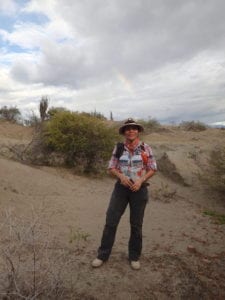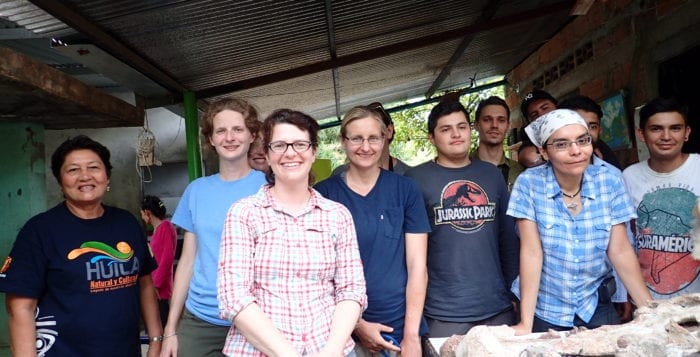By Daniel Dunaief
It’s like that old bus riddle. The bus starts out with 20 people. Six people get off, then eight get on, two more get off, 12 enter, eight exit, and so on until, lo and behold, the bus has either the same number of people or someone asks the identity of the driver.
In this case, though, the bus is a collection of Caribbean islands called the Greater Antilles, which includes the Dominican Republic, Cuba, Hispaniola, Haiti, Puerto Rico, the Cayman Islands and Jamaica. The passengers are not people; they are species of bats.
Working with Luis Valente, a postdoctoral researcher at the Natural History Museum of Berlin, Liliana Davalos, an associate professor of conservation biology/ecology and evolution at Stony Brook University, recently determined that the number of species of bats, like the people entering and leaving the bus, remained in relative equilibrium for millions of years over many generations.

While several species of bats will colonize the islands and new species will also form over that long time scale, the rate of natural extinction in that time balances out the islands’ diversity gains, leaving the metaphorical bus with about the same number of species.
Famous biologists Edward O. Wilson and Robert MacArthur came up with the theory of island biogeography in 1967, which might help explain how the number of species of bats remained in equilibrium for millions of years. The theory proposes an equilibrium between colonization and extinction.
For bats, however, that balance changed. About 20,000 years ago, fossils of extinct species made their final appearance, while other species died off about 3,000 to 4,000 years ago. So, what happened to the bat bus?
The last ice age accounts for some of the declines about 20,000 years ago. More recently, the arrival of people altered conditions on the islands. At least two other waves of colonization occurred before the arrival of Europeans, with people changing the landscape through agriculture. While hunting of other mammals is evident from the archeological record, it is less certain how changes on the land affected bats. It’s difficult to pinpoint the exact time when each species went extinct, although many of those events happened after people arrived on the islands, changing the region’s equilibrium.
Davalos’ previous work had found that the number of species lost was as predicted if the losses occurred because of the rising sea levels at the end of the last glaciation. If that were the case, many of those species would have disappeared around that time. Some of her colleagues, however, dated the remains of bats and found that these species became extinct more recently, over the last few thousand years.
“While we cannot be certain that all bat extinctions were caused by humans, evidence increasingly seems to suggest so,” explained Valente in an email. “All over the world, colonization of islands by humans has led to many extinctions of local species, because islands have very unique species that are very prone to any disturbances.”
The researchers used computer simulations to calculate that it would take nature eight million years to restore bat biodiversity. “Some people argue that if we leave nature alone it will quickly return to its original state,” Valente explained. “However, the finding that it would take eight million years to recover lost diversity suggests that is clearly not the case.” Valente, who described Davalos as a “wonderful collaborator” who was “actively involved in the project at all stages,” wrote that this study “raises awareness for conservation of the unique bat species of the Caribbean.”
While there is still work ahead, the “nations of the Greater Antilles have amazing natural parks to protect their biodiversity,” Davalos explained. In the tropics of the Western Hemisphere, Puerto Rico is the “number one example of a forest growing back,” Davalos said. “Puerto Rico is one of the places in the world that has had more of a resurgence of the forest.”
The preservation of biodiversity remains threatened even now as at least three bat populations on the Greater Antilles are threatened with extinction and two might already be extinct. Still, the effort is not “hopeless,” she said, as there are some large populations of bats thriving on these islands. Davalos and her colleagues were able to make these discoveries by examining the bat in detail.
A resident of Setauket, Davalos has been at Stony Brook University for eight years. She enjoys kayaking on Long Island and visiting local and state parks. Over the last few years, she has spent her free time on staycations, where she sees a protected area of Long Island each day.
From a young age, Davalos recalls being interested in science. Indeed, when she was only 4, she saw a documentary where Louis and Mary Leakey showed the results of their expeditions where they collected human fossils in Kenya. “From that moment on,” Davalos recalled, “I thought, ‘Some day, this is what I’m going to study.’” Her family and their acquaintances suggested that pursuing such a career path would be challenging.
She tells her current SBU students that she’s “the luckiest person in the world, living out my childhood dream.” Last year, she went on her first fossil dig in Colombia, where she joined a team from Grand Valley State University in Allendale, Michigan, and Johns Hopkins. She found fossils from bats that were 12 million years old.
While Davalos has never met the Leakey family, she wants to tell them that, “Children are watching and [their work] can have a huge effect” on their dreams. Some day, Davalos hopes a future scientist may say the same thing about her research.





